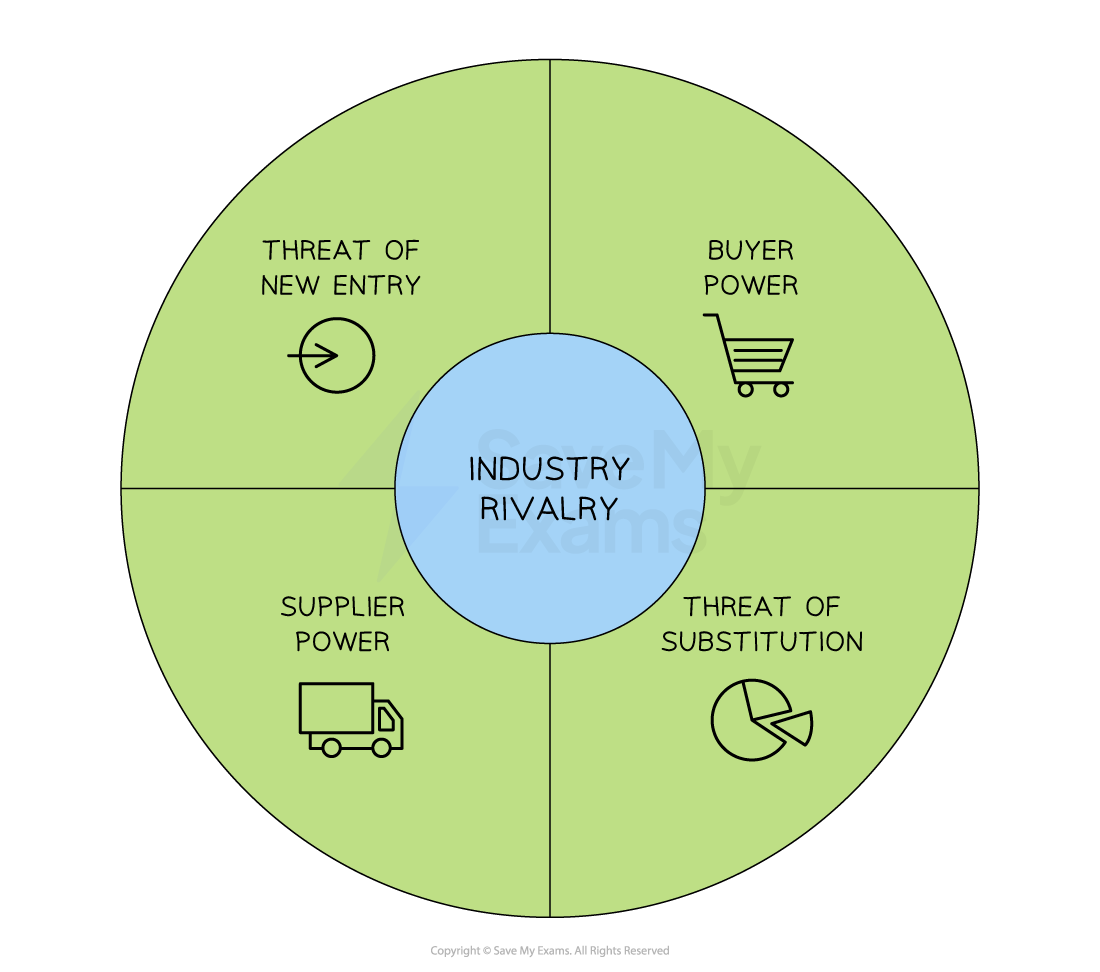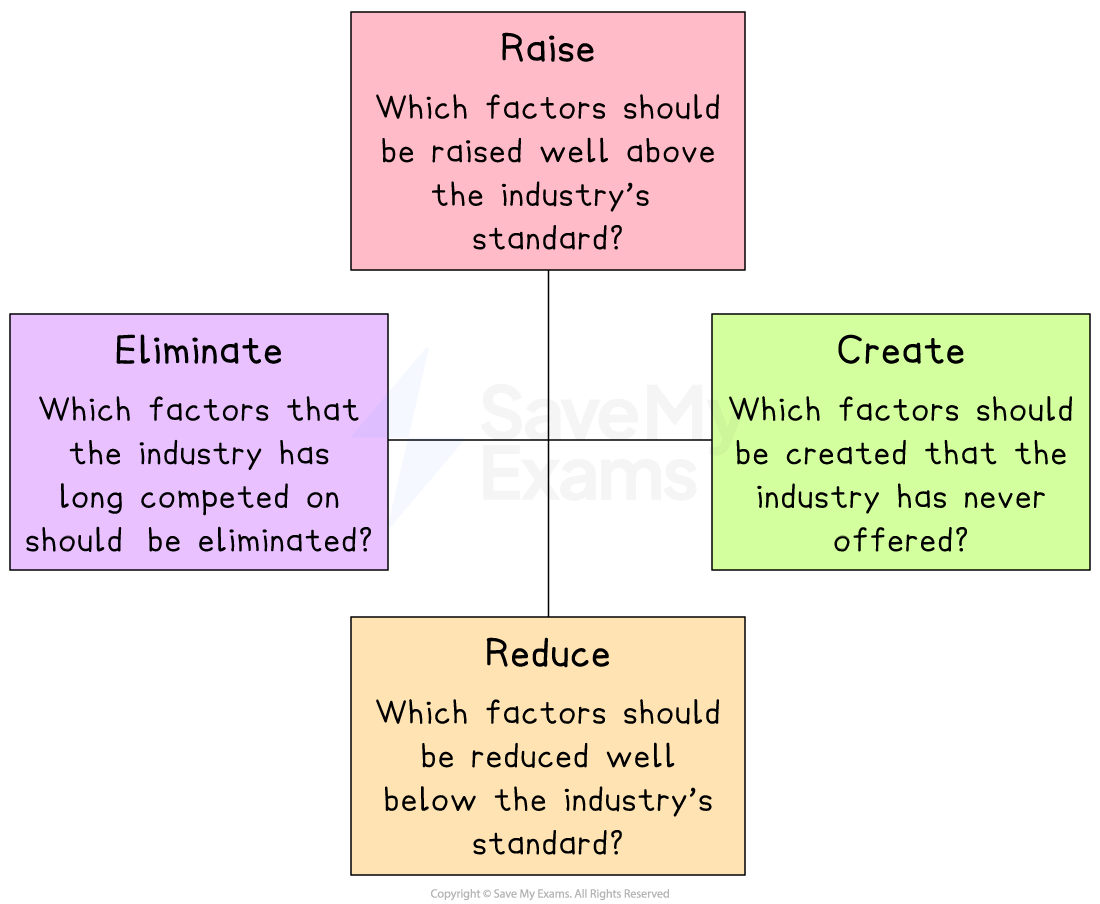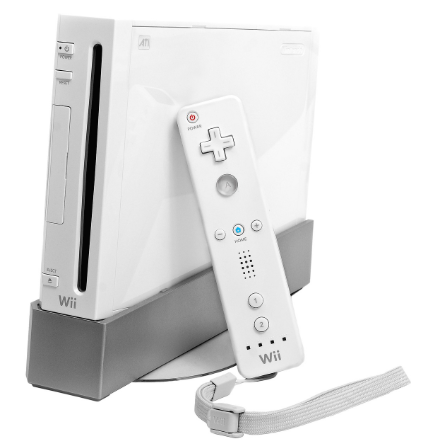Porter's Five Forces and Blue Ocean Strategy (Cambridge (CIE) A Level Business): Revision Note
Exam code: 9609
An introduction to Porter's Five Forces model
Porter’s Five Forces identify the key pressures on an industry that impact the ability of a business to compete with rivals
It helps managers think strategically about the environment in which the business operates
Porter's five forces

Once a business fully understands these pressures in their context, they can take strategic decisions to achieve and sustain a competitive advantage
Explanation of Porter's five forces model
Force | Explanation | Example |
|---|---|---|
Industry rivalry |
|
|
Threat of new entry |
|
|
Buyer power |
|
|
Supplier power |
|
|
Threat of substitution |
|
|
Porter's generic strategies
Once a business has applied the Five Forces model to its own circumstances, Porter recommended a range of generic strategies to increase its chances of competing
On the basis of cost or through differentiation
In the mass market or within a smaller niche market
It emphasises the importance of developing distinctive capabilities and avoid being 'stuck in the middle'
Porter's generic matrix

Mass market strategies
Cost Leadership
Most suitable for businesses that have a significant cost advantage over rivals
Cost leadership with parity is where a business has lower costs than rivals but charges the same price
Examples include hotel chains such as Premier Inn and Ibis Styles
Cost leadership with proximity is where a business has lower costs and charges a lower price than rivals
Examples include budget airlines such as Southwestern and Ryanair
Differentiation
Businesses that cannot be the most competitive on cost should make its products distinct from those of rivals
This allows a business to charge a premium price and achieve a high profit margin
Examples of businesses that adopt a mass market differentiation strategy include
Coca Cola, whose trusted and well-known branding includes its logo, brand colours and characters such as the Coca Cola truck
Samsung's cutting-edge mobile phones have the most advanced package of technical features in the mass market
Volvo's focus on safety and build quality allows it to charge premium prices in the mass market
Niche market strategies
Businesses that operate in a niche markets should adopt one of two focus strategies that closely meet the needs of its specific group of customers
Cost focus strategy
This involves being the lowest cost competitor within the market niche
Carnival Cruises sells cruises to locations including the Caribbean and Europe and is well-known for it's eye-catching low fares that can be offered due to its fleet of smaller vessels that operate at full capacity
Glasses Direct is an online retailer of spectacles that sells popular styles of lesser-known brands at very low prices as a result of its low overhead costs
Differentiation focus strategy
A differentiation focus involves offering specialised products within the niche market
Hotel Chocolat sells a range of premium, fair-trade celebration confectionary in its chain of beautifully-designed retail outlets
Brompton Bicycle Retail sells innovative products, such as the folding bicycle, that closely meet the needs of its wealthy commuter target market
Stuck in the middle
Failing to adopt one of the strategies would result in being unable to compete successfully with rivals
A business should select its strategy and concentrate its resources on pursuing it rather than simply responding to its competitors' actions
Pursuing a mixture of strategies is also not feasible in the long term
Cost leadership and differentiation are not compatible
Low prices combined with high quality can negatively affect consumer perceptions of the product
Evaluation of Porter's generic strategies
Benefits | Drawbacks |
|---|---|
|
|
Examiner Tips and Tricks
Although Porter's Generic Strategies are not explicitly listed within this specification, it is important that you understand that Five Forces Analysis allows a business to determine its competitive strategy. For this reason it is included here.
Additionally, as Blue Ocean Strategy is an alternative to Porter's acceptance of competitive forces in his Generic Strategies (Kim & Mauborgne consider these to be Red Ocean Strategies) it is appropriate to understand the concept.
Blue ocean strategy
Blue Ocean strategy is the simultaneous pursuit of differentiation and low-cost strategies
This opens up a new market space and creates new demand, so there is less fighting over existing demand
Uncontested market space is captured by products that other businesses have not yet adopted, making competition irrelevant
There is ample opportunity for profitable and rapid growth
Businesses pursuing this strategy follow the Four Actions Framework to identify a new value curve which combines cost and differentiation in a new, innovative way
The four actions framework

The four actions in the framework are:
Raise
Question which features or products should be better than the industry standard
Create
Question which features or products have never existed and should be created
Reduce
Question which features of products should be downplayed to levels below industry standards
Eliminate
Question which features or products have been overcompeted and eliminate them
Case Study
Nintendo's Blue Ocean strategy
In the early 2000s, Nintendo was struggling as industry giants Sony and Microsoft dominated the market

In 2006, the company took a blue ocean approach
It researched the needs of non-gamers rather than customers who already owned games consoles
It eliminated or reduced factors that were thought to be vital in the market, such as high-definition graphics, fast chips, controllers with many buttons and violent, lifelike games
It raised and created factors that appealed to non-gamers, such as more accessible games and a focus on fun and intuitive controls
The result was the Nintendo Wii, a console based on simplicity, functionality, and interactivity, which opened up a new market that went on to outsell all Sony and Microsoft gaming products combined
Examiner Tips and Tricks
The choice of business strategy will be determined by the attitudes, experience, and leadership skills of key decision-makers in a business
Risk-averse senior managers are unlikely to pursue blue ocean strategies, for example.
Look for clues in the case study to establish the leadership style of senior managers, as this could help you build a strong chain of analysis and make a justified recommendation.

Unlock more, it's free!
Did this page help you?